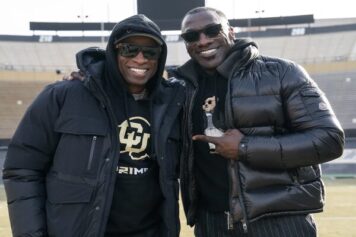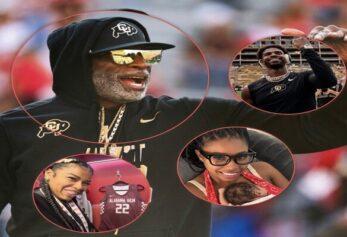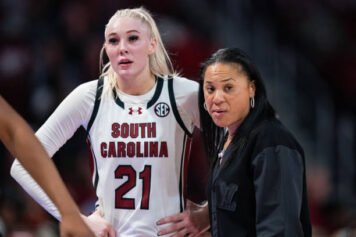“There’s no manual for this job. I’ve been lucky to be around some of the best coaches, a Hall of Famer in R.C. (Slocum), Coach (Bob) Stoops is going to be in the Hall of Fame. Joe Tiller’s won a bunch of games, winningest coach in Purdue history, probably. Glen Mason, Mike Price. I’ve just been real fortunate to be around some guys that I’ve learned a lot from. But at the end of the day, you’ve got to be yourself. In a lot of these situations, you don’t have a chance to take it in until it’s over with.” – Kevin Sumlin
Johnny Manziel isn’t an imposing figure at 6’1, 200 pounds. But the latest Heisman Trophy winner is the prime example of what’s being called the “Super Quarterback” in college football. These are often dudes who are just as deadly with their legs as the throwing arm.
Like Cam Newton who came before him, Manziel is as dynamic an offensive player as there is in college football.
The Manziel factor and this excitement around the Texas A&M football program is enough to establish more confidence in the hiring of Kevin Sumlin, even if it wasn’t there to begin with. But, no doubt, that success accelerates the expectations past this season. And for all the upside of having Sumlin as a head coach – his leadership qualities, recruiting ability and record – there’s still concern that “time of possession” is a dual stat that applies specifically to black coaches at white institutions.
More specific to the Aggies’ situation, there is the view that success in 2012, along with Manziel winning the Heisman, ties up Sumlin’s hands and forces his short term status as head coach to be directly connected to Manziel. Call it the burden of success.
After all, the expectations for Manziel were even lower than they were for Sumlin. The Aggies were supposed to have a rotation of three average quarterbacks until a high school prospect from Dallas named Kenny Hill made his way to College Station in 2013. So much for that.
“They’ve set the bar so high, a six-win season is unacceptable,” said Dennis Ransom, who played tight end for the Aggies from 1986-90. “I was happy that Manziel won the Heisman, but my concern is now that he’s won the Heisman, if he doesn’t put up the numbers like he did again, what do you writers say about his career? And what does Sumlin do if Manziel underperforms? You can’t bench him because he won the Heisman.”
When Texas A&M hired Sumlin as head coach of its football team a year ago, no one was expecting the Aggies to look like a Southeastern Conference powerhouse in their first season in the league.
In talking with former players, it’s clear that six wins and a bowl game appearance would have been deemed successful in this transition phase. So you know a 10-2 record, including a win against then-No. 1 Alabama, has the folks in C-Stat yee-hawing and square-dancing.
“The brother (Sumlin) is a winner,” said one of Ransom’s former Aggie teammates, recalling picking Sumlin’s brain in the head coach’s first stint with the Aggies as an offensive coordinator more than a decade ago.
This Aggie, who finished his career at A&M 20 years ago, spoke to TSL about what he thought of the Sumlin hire and what it could do for the program under conditions of anonymity .
“He knows how to win. With them scoring all these points and flying all over the field, that ain’t no surprise because he was doing it at Houston, too. So it’s just like one of those things, are they going to give him enough time?
“All of us were thinking, ‘man if they win five or six games in the SEC, that would be pretty good for the first year, but they’ll have to win the second year. None of us expected 10 wins in Year 1, which is great. That’s wonderful. But we didn’t expect that. So now that we have it, it’s like, where do we go from here? I mean, because obviously you can’t go back now. We can’t go back to 6-6, or they’ll really be hollering.”
***
So much of a coach’s success has to do with how the situation is evaluated. One of the questions Ransom and a lot of his teammates had when Sumlin was hired was if the new A&M head coach realized what he was walking into.
“As a black coach or a potential head coach, I think you’ve got to look at your situation going in there,” Ransom said. “You’ve got to look at the recruits you’ve got, the players you’ve got, how the athletic director is committed to you and the program. When you’re looking at these opportunities as a coach, you’ve got to be realistic.”
The obvious question here asks what in the hell took so long? 2012 was the first season a black former A&M player was hired to the assistant coaching staff (defensive line coach Terry Price and NFL liaison Larry Jackson). That’s 45 years after the first black players joined the team. The impact of diversity in the Aggies’ coaching staff is an unmistakable factor in the program’s potential to be successful in the SEC for years to come.
In terms of recruiting, the Aggies could dominate the league and the state, even better now that the two are no longer mutually exclusive. Remember Thomas Johnson, the freshman wide receiver at A&M that supposedly went missing for a couple of days this season? Sumlin was able to steal Johnson from Texas after a solid verbal commitment to the Longhorns.
“These young kids coming out of school, man, it ain’t all about the football thing with them sometimes. It’s about the appeal of the university,” Ransom said. “That’s why I was impressed with A&M, to put them blinders on and say we’re going to make some changes. These kids are going to come to A&M, man. They’re going to come to A&M for the simple fact that Manziel won the Heisman, now they’re on TV, in the SEC, and they made some changes.”
A&M seemed to be all about breaking barriers this season, even beyond the initial success in the SEC. While it’s always been known as a great institution to receive a degree from, Texas A&M has never been the model for how to go about achieving diversity.
The number of black students in College Station has actually only increased slightly in the last 20-plus years. It went from roughly 1,200 black students out of a 40,000 student population in 1989 to 1,700 out of 50,000 in 2012. So in terms of black inclusion, percentage-wise, Texas A&M is the same as it ever was.
“Man, realistically I was surprised that they hired Sumlin,” Ransom said. “It’s something we never thought would probably happen down at A&M, a black coach coming in. But I think it showed that they were really committed to making some changes, even as far as tradition, bringing a black head coach in there.
“I make the statement sometimes, you know he’s also married to a white girl. So for them to say we’re going to overlook all of this, you know what I’m saying? When that time came, they knew there had to be a change. They knew going into the SEC, they couldn’t win with some of the talent they had.”
****
Perhaps the most integrated part of the academic institution is major athletic fields of play, like football. For a number of reasons, it’s not quite that way in the coaching ranks. Dr. Richard Lapchick is the director of The Institute for Diversity and Ethics in Sport at Central Florida. Lapchick’s research with the Black Coaches and Administrators showed a record total of 28 head coaches of color on the NCAA Division I level, including FCS schools but excluding historically black colleges and universities. In BCS conferences, there were just seven minority coaches.
Recently fired head coach of Colorado, John Embree, seemed to be eulogizing his career as an FBS head coach in his farewell press conference.
The discussion resurfaced on whether or not minority head coaches get enough time to prove themselves by turning around what are often terrible programs to begin with. This was not a problem for Sumlin, whose coaching lineage begins with his father Bill and goes all the way through Joe Tiller, R.C. Slocum and Bob Stoops.
“We don’t know what to expect because all of us are in the situation for the first time, you know what I mean,” said a former Aggie that agreed to speak, but only under the condition of anonymity. “Like I said, all of us former players want this brother to be there for 15 years. I don’t want the dude to get fired, then they bring in John Q white guy and all of a sudden we’re back to the way it was.
“I think the main question was why did it take so long? We can come play for you, sweat for you, uplift the program, but it still took this long? Every single one of us wants this dude (Sumlin) to keep this thing going because as soon as it goes bad, it’ll be like ‘get ‘em out of here, get ‘em out of here, how much is the buyout’ and all of that.”
The key with Sumlin is his good fortune in turning around a program before that proverbial clock really starts ticking.
“Going into the SEC with your first African-American head coach, I think there were a lot of doubters,” said Alton Gillis who played for the Aggies from 1987-91. “We’ve read articles and books published on the subject alone, and just given the opportunity I think Sumlin has done a good job.
“I think you have to set the bar for yourself and Sumlin is a coach that sets high expectations of himself and his team. You kind of sense that from Manziel, as well. You recall his (Heisman) speech, you’re always looking to better yourself. The way I see it, they’ve set the bar and expectations high, but the great teams do that. You talk about the Sabans of the world and true champions in the college ranks. That’s what they do each and every year, each and every game.”
****
Does Manziel really hold all the cards for the Aggie football program? No one is giving official figures, but some former players speculate that Texas A&M could stand to profit anywhere from $40-$50 million using Manziel’s likeness and marketability, which backed up by recent reports about Heisman windfalls. The kid won’t see much of it, but he’s on track to pick up his degree from a fine institution, so who’s counting?
“Johnny is one of the few to come through any college and become the quarterback he is right now,” said Percy Waddle, an Aggie wide receiver in the late 80s. “The kid’s got heart. He’s the real deal. Personally, he’s one of the best quarterbacks I’ve seen in a while.
“You know, Sumlin got to A&M and Johnny is going to draw in some recruits, too.”
But since they won’t pay Manziel, what about Sumlin? He went from being a questionable coaching hire with his share of doubters internally, to having one of the more memorable seasons in school history. Gillis remembers feeling like the Aggies could compete against SEC competition even when he played in the early 90s. Now it’s actually happening, the stakes are raised and notoriety is at an all-time high.
Sumlin’s current deal is for five years, worth $2 million annually. That’s chump change in the SEC. For context, Gene Chizik made at least $3.5 million at Auburn this season, and the university paid him almost as much just to go away.
“A lot of us former players gave him 24 months in College Station,” Ransom added. “I’m serious. Now, the big question I have for A&M is if this man had all this success, Manziel won the Heisman, do you tear up his contract and give him a new one, or do you tell him to do it again next year and we’ll reward you? That’s what I want to see. Do you give him the money now?”
Even if revenue is up significantly from the exposure that came with Sumlin and Manziel’s first season in the Aggie spotlight, there's hypocrisy in advocating for the raise of any college football coach until players start getting paid. But Mike Sherman was awarded a $400,000 raise for a 9-4 season and a trip to the Cotton Bowl in 2010. He was fired the next season when the Aggies finished 6-6.
If 9-4 in the Big 12 is worth a raise the size of the (United States) president’s salary, then 10-2 in the school's SEC debut should make it thunder. At the very least, it should give Sumlin some cushion to fall on if he needs it.



